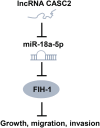CASC2 inhibits the growth, migration, and invasion of thyroid cancer cells through sponging miR-18a-5p/FIH1 axis
- PMID: 33336500
- PMCID: PMC11896376
- DOI: 10.1002/kjm2.12331
CASC2 inhibits the growth, migration, and invasion of thyroid cancer cells through sponging miR-18a-5p/FIH1 axis
Abstract
Long noncoding RNA (lncRNA) Cancer Susceptibility 2 (CASC2) has been proved to contribute to the development of cancers. However, the mechanism behind the action of CASC2 in thyroid cancer is not quite clear. We demonstrated that CASC2 was downregulated in thyroid cancer. We noted that CASC2 overexpression restrained the growth, migration, and invasion of thyroid cancer cells, whereas CASC2 depletion caused opposite trends. Bioinformatics analysis predicted that hypoxia inducible factor 1 subunit alpha inhibitor (FIH-1) was potentially targeted by miR-18a-5p, which was confirmed by luciferase reporter assay. Upregulation of FIH-1 abrogated the promotive effect of miR-18a-5p on the growth and invasion of thyroid cancer cells. In addition, CASC2 serves as a competing endogenous RNA (ceRNA) and a ''sponge'' for miR-18a-5p, thereby regulating the expression of FIH-1. These data elucidated the CASC2/miR-18a-5p ceRNA network in thyroid cancer pathogenesis.
Keywords: CASC2; invasion; proliferation; thyroid cancer.
© 2020 The Authors. The Kaohsiung Journal of Medical Sciences published by John Wiley & Sons Australia on behalf of Kaohsiung Medical University.
Figures






References
-
- Sedaghati M, Kebebew E. Long noncoding RNAs in thyroid cancer. Curr Opin Endocrinol Diabetes Obes. 2019;26(5):275–81. - PubMed
-
- Murugan AK, Munirajan AK, Alzahrani AS. Long noncoding RNAs: Emerging players in thyroid cancer pathogenesis. Endocr Relat Cancer. 2018;25(2):R59–82. - PubMed
-
- Qu X, Alsager S, Zhuo Y, Shan B. HOX transcript antisense RNA (HOTAIR) in cancer. Cancer Lett. 2019;454:90–7. - PubMed
-
- Li Q, Song W, Wang J. TUG1 confers Adriamycin resistance in acute myeloid leukemia by epigenetically suppressing miR‐34a expression via EZH2. Biomed Pharmacother. 2019;109:1793–801. - PubMed
MeSH terms
Substances
Grants and funding
LinkOut - more resources
Full Text Sources

